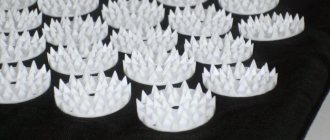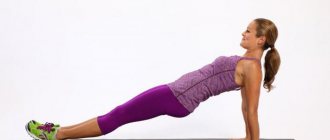Vacuum abdominal exercises are believed to help train the internal abdominal muscles. That is why many trainers recommend including them in the training program for anyone who wants to get rid of extra centimeters on the waist. After all, even the most naturally slender people have a layer of fat in this area. Albeit to a small extent.
What is a vacuum exercise?
A vacuum is an exercise during which you need to exhale the air completely, empty your lungs, and then hold your breath and pull in your stomach as much as possible. After holding this for a certain time, you need to relax and take a deep breath. Vacuum exercises help strengthen the internal abdominal muscles. If you do them regularly, and most importantly, correctly, the core muscles develop and the stomach becomes toned.
However, not everyone can perform a vacuum, and not always. Thus, you should not include exercise in the training program during menstruation, pregnancy, uterine fibroids, acute infectious diseases of the abdominal and pelvic organs, exacerbations of chronic digestive diseases, thromboembolic disease, as well as malignant tumors of any location.
How is a vacuum useful and what does it give?
The vacuum trains internal muscles that are difficult to use in other ways and that we often forget about. One of them is the transverse muscle, which tightens the ribs during breathing and is also responsible for stability of the body while walking. If you properly strengthen this muscle, you will feel more confident when running, walking, and doing strength exercises. But in addition to improved stability, you will also receive aesthetic benefits - your abdominal muscles will become more toned and defined.
There is one more very useful and necessary property of this exercise - it strengthens the pelvic muscles, which, like a hammock, support the internal organs. If these lower muscles are weakened, then no amount of crunching will help you - your waist will remain wide because the organs are literally falling out. The internal muscles are too weak to hold them in place. And the vacuum will allow you to pump them up to improve posture and stability and make your waist a little narrower.
Read more about contraindications to performing a vacuum
Despite the obvious benefits of this exercise, in some situations it can harm your health. For those who have chronic diseases, it is better to consult a doctor before including it in the program. Thus, vacuum is not recommended for:
- stomach ulcer and gastritis;
- other gastrointestinal diseases;
- pathologies of the heart and blood vessels;
- blood pressure problems;
- thrombosis;
- hernia.
In addition, you should refrain from performing the exercise in the first six months after abdominal surgery and during menstruation.
If, while doing a vacuum, you feel pain in your stomach, which stopped immediately as soon as you stopped doing it, take a week's break. After 7 days, try again. In a situation where pain is present again during movement, be sure to consult a doctor. Perhaps such loads are contraindicated for you.
Benefits and harms
Aesthetic improvement is not the only positive effect of the abdominal vacuum exercise. A properly strengthened transverse muscle can relieve some of the load from the muscles of the lumbar spine and lower back and reduce pain in dorsopathy (chronic pathology of the spine).
The developed muscles of the anterior abdominal wall, like a transverse belt, hold the internal organs in their natural position, thus contributing to their proper functioning, and its correct functioning and metabolism depend on the physiological position of the intestine. This exercise also helps prevent visceroptosis (prolapse of internal organs).
This exercise can also cause harm. In particular, you will have to abstain from it in case of a number of diseases. It is advisable to consult a doctor before starting training.
Performing a vacuum exercise for the abdomen should begin with minimal loads, but then gradually increase the effort. Then the training will bring benefits and emotional uplift.
Why do the vacuum exercise?
Those who have to watch their diet in order not to gain weight should pay attention to the vacuum first. Of course, static exercises alone will not be enough to achieve a wasp waist. You can’t do without dynamic ones, which help to work the rectus and oblique external abdominal muscles. Only a competent combination of these and other exercises within the training scheme will help achieve the desired results.
Along with the common plank, the vacuum helps train the transverse muscles. The transverse muscles perform one of the most important functions in the human body - they support the internal organs of the abdominal cavity and the spine. At the same time, they are considered the most problematic area. After all, it is quite difficult to set a sufficient load during transverse training (due to the depth of this muscle group).
Without systematically performing targeted exercises, the transverse muscles quickly relax, stretch, and become overgrown with fat deposits. It is very difficult to return them to their previous shape later.
If you perform the abdominal vacuum exercise correctly, you can feel how not only the abdominal muscles, but also the diaphragm are involved in the work. That is, this movement teaches the athlete to breathe deeply. Thanks to it, lung capacity increases and problems with posture disappear. In addition, during the vacuum process, a light massage of the internal organs occurs. Yoga adherents believe that such indirect massage increases metabolism in the human body.
Benefits of Exercise
When planning to include a vacuum in your training program, you should know what benefits its regular implementation will bring:
- Reducing waist size.
- No need to use special sports equipment.
- Increased neuromuscular connection with the abdominal muscles.
- Strengthening the diaphragm and increasing lung capacity.
- Improved blood circulation.
- Regular gentle massage of internal organs.
- Strengthening the back muscles, straightening the posture.
- Calming effect on the nervous system.
Of course, it is a mistake to think that you will be able to achieve tangible results just a week from the start of classes.
To achieve the desired result (a thin waist and a flat stomach), you need to perform vacuum press exercises constantly. And of course, supplement the complex with other movements (dynamic), as well as adhere to proper nutrition.
Plank exercise
The plank is an inherently overrated exercise that is no more effective than any other. It also has its pros and cons.
Positive effects:
- According to the mechanics of action on muscles, the plank is a static exercise that activates the work of many muscle groups. It really helps strengthen your abs and tighten your stomach.
- The plank also helps strengthen the muscles of the back, shoulders, arms, legs and even buttocks.
How to do it right
You can perform the vacuum movement standing, kneeling, sitting or lying down.
Vacuum while lying down
The simplest implementation option. Perfect for beginners who are just starting to master such exercises.
Lie on your back, bend your knees, extend your arms along your body or place them on your stomach.
Exhale smoothly, feel how your lungs are completely freed from air. Tighten your abdominal muscles as much as possible, drawing in your stomach (as if you are trying to pull it towards your spine). Stay in this position for 10-15 seconds. Now take a shallow breath, trying not to relax your muscles. Repeat several times, then relax and regain your breathing.
Seated technique
You can do this exercise either sitting on a chair or on your shins. Try both options and decide which one is more convenient for you.
Take a sitting position, place your hands on your hips, keep your back straight.
Inhale and exhale deeply, completely releasing the air from your lungs. After exhaling, pull your stomach in as much as possible, as if you are trying to press it to your spine. Stay in this position for 10-15 seconds (do not inhale). After the specified time has passed, relax and restore your breathing.
Performing the exercise while standing
This is the main method, which should be switched to after mastering the previous techniques.
Stand straight, spread your legs slightly so that your feet are hip-width apart. Now bend over a little and place your palms on your thighs.
Take a deep breath and exhale through your nose. Completely emptying the lungs of air. At the same time, pull the walls of the abdominal cavity towards the spine as much as possible (pull your stomach in strongly).
Hold your breath for 5-10 seconds. Don't relax, keep holding the "belly under the ribs." Make sure your back remains straight. Exhale smoothly, repeat the exercise after 20-30 seconds.
Kneeling technique
This execution variation is more complicated. Suitable for those who have successfully dealt with the previous methods.
Get on your knees, place your palms on them. Next, smoothly lower yourself to a sitting position, but in such a way that there is at least 20 cm between your buttocks and feet. Lean forward a little, try to round your back.
Now take a deep breath and exhale and draw in your stomach as much as possible, holding your breath. Try to hold this position for 20-30 seconds. After the time has passed, inhale and exhale again and retract the abs.
Execution technique
An important technical point when performing the “vacuum” exercise is proper breathing. The correct algorithm looks like this:
- Take the starting position.
- Take a deep breath through your nose.
- Exhale as completely as possible through your mouth in order to completely empty your lungs of air, followed by holding your breath.
- Simultaneously with exhalation, pull in the stomach with muscle effort and press the anterior abdominal wall into the spine. At this time, the abdominal organs will move upward, towards the hypochondrium.
- Having pulled in your stomach, fix this position for 15 seconds. If at the initial stages it is not possible to hold your breath for this time, a shallow breath is allowed, but without relaxing the abdominal muscles. How long a person can hold their breath is an individual parameter, so you should not immediately strive for high results; they will come after systematic training.
- Slowly resume breathing, gradually relax your abdominal muscles (do not allow sudden inhalations and exhalations).
- During the pause, take two or three calm breaths in and out to restore your breathing rhythm.
- Repeat again, starting with a deep breath through the nose.
With regular training, the time should be gradually increased with the goal of bringing it to 1 minute. To ensure that your efforts are not wasted, you need to perform exercises with the correct technique at least 5 times a week (3-5 repetitions each).
Video: technique for performing the “Vacuum” exercise
Tips for Beginners
For those who are just beginning to comprehend the basics of the technique of performing vacuum exercises, it is better to adopt the simplest method - lying down.
Get into the habit of starting your morning with this movement. Right in bed, before you get up and have breakfast, lie on your back, bend your knees. Exhale, completely emptying your lungs of air. At the same time, tighten your abdominal muscles as much as possible, drawing in your stomach. You need to hold your breath in this position for as long as your body allows you. Now inhale, trying not to relax too much, and exhale again. Repeat the exercise several times.
At first, it is enough to hold the vacuum for 10-15 seconds in 3-5 approaches. But gradually the load needs to be increased, including a vacuum in the morning complex from a sitting and standing position.
How many times should you do it and how often?
You can do this exercise every day, but it is better to include it in the main complex 3-4 times a week. This way you will achieve greater efficiency and see results faster.
Beginners need to hold their breath for 10-12 seconds, experienced athletes - for 15-20. The duration of execution should be gradually increased, starting from 15 and eventually reaching 60 seconds.
What is a belly vacuum?
Vacuum is an extremely simple movement. You don't need any equipment or training equipment. It can be done at home. It tightens not only the abdominal muscles, but also many small but important muscle groups of the torso. The internal muscles located under the abs are mainly worked. Since the torso muscles are a large muscle group, the vacuum also trains the heart. You will also notice improved mobility and flexibility, and your waist size will decrease.
Vacuum is a breathing exercise that targets the transverse muscle, which tenses as a result of isometric contraction.
Vacuum press training program
At the initial stage of training, when you have just started mastering the technique, you should perform 5-6 approaches for 15-20 seconds. You need to rest no more than 1 minute between sets.
By doing a vacuum in this mode for a week, you will feel that the exercise has become easier. This means that the load needs to be increased. Now try to pull your stomach in as much as possible for a longer time - 30-35 seconds. After another 7-14 - at 45-50, etc.
Don't forget that the total duration of the workout should not exceed 25-30 minutes. Afterwards, an adverse effect begins on the nerve endings of the gastrointestinal tract, which can lead to a number of unpleasant consequences (heartburn, bloating, etc.).











